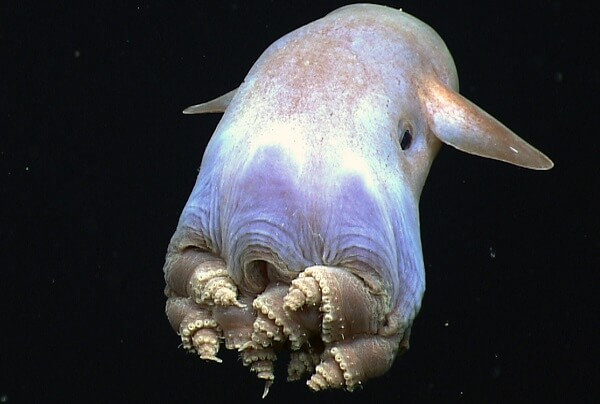
The Dumbo Octopus is the common name for a genus of octopuses that live in the deepest parts of the ocean. The average depth of most dumbo octopus species is 13,100 feet (~4,000 m), though some have been found as deep 23,000 feet (~7,000 m)! Because of this very deep niche, dumbo octopuses have some very interesting adaptations. First, a distinguishing feature of the dumbo octopus is the ear-like fins near the eyes. These fins are used to steer the octopus as it glides through the abyss. These fins bear a striking resemblance to the ears of Dumbo, Disney’s classic animated elephant character. Second, dumbo octopuses have completely lost their ink sacs. Most octopuses use their ink sacs as a predator defense, leading scientists to believe that the dumbo octopus has very few natural predators. The dumbo octopus hunts crustaceans, worms, and other invertebrates that inhabit the pitch-black depths of the ocean. As part of the Opisthoteuthidae family of umbrella octopuses, the dumbo octopus has skin between its arms that allow it to form a net around its prey. This lets the dumbo octopus capture prey that is quite large! The dumbo octopus is not just a funny-looking sea creature. In fact, the octopus has a lot to teach us about biology and evolution! Interestingly, no species of dumbo octopus discovered has a functional ink sac. This is very peculiar because the ink sac is a trait that is found in most species of octopus and squid. In fact, it is a defining characteristic of the entire class Cephalopoda. So, the lack of a function ink sac begs the question: Where did it go? Evolution is a process that rewards organisms that use their energy in the most efficient ways. For most cephalopods, the ink sac is an indispensable adaptation because it allows them to confuse and hide from predators. Without the ink sac, most cephalopods would be much more vulnerable to sharks, whales, and large fish that try to eat them. But, there are few large predators in the depths of the ocean. Part of this is due to the fact that there is very little prey at extreme depths. So, without many sharks, whales, or large fish, the dumbo octopus would rarely (if ever) be required to use an ink sac to escape from predators. Since the ink sac costs energy to grow, maintain, and fill with ink, it would be a complete waste for the dumbo octopus to keep its ink sac. Some time ago, an octopus mutated to not have an ink sac and was, therefore, able to produce more offspring than its relatives with ink sacs. This adaptation was very good, which is likely why all dumbo octopuses are without ink sacs! Like many deep-sea creatures, the dumbo octopus has a number of adaptations that allow it to live at extreme depths. Water is very heavy, so animals that live that deep need to be adapted to extreme pressures. One of the most common adaptations to deal with this pressure is a gelatinous body. Most dumbo octopuses, as compared with their shallower cousins, have a very delicate and soft body. The extreme pressure of their environment helps keep this body together. At the surface, most soft-bodied organisms cannot survive because there is simply not enough pressure for their bodies to operate normally. Though the Dumbo octopus was first discovered and recognized as early as 1883, a live specimen was not seen until the first deep-sea submersible vessels were invented in the 1990s. Marine biologists still have a lot to learn about these mysterious cephalopods!
Kingdom
Animalia
Phylum
Mollusca
Class
Cephalopoda
Order
Octopoda
Family
Opisthoteuthidae
Genus
Grimpoteuthis
Species
13 recognized species
Niche
Deep-sea Predator
Length
Up to 5’10” (1.8 m) (most around 12″)
Weight
Up to 13 lbs (5.9 kg)
Lifespan
3-5 years
Social Structure
Solitary
Conservation Status
Least Concern
Preferred Habitat
Bathypelagic, Abyssopelagic, and the Hadalpelagic zones (3,281 feet – 36,100 feet deep)
Average Clutch Size
Unknown
Main Prey Species
Crustaceans, Polychaete worms
Predators
Few predators
The Basics

Fun Facts about Dumbo Octopuses!
Unused Adaptations
Life in the Abyss

